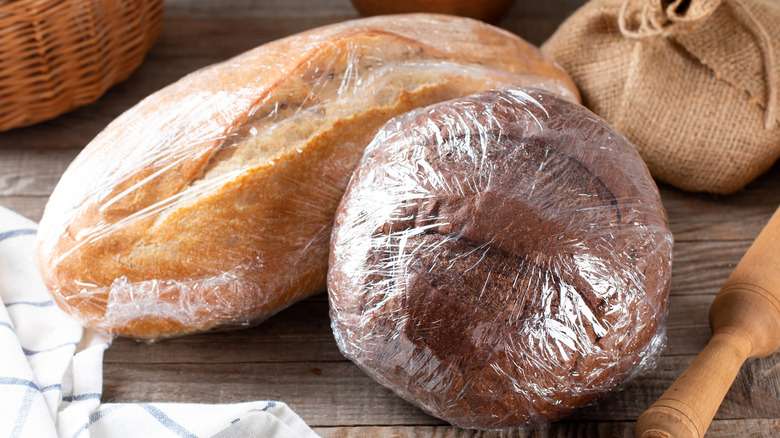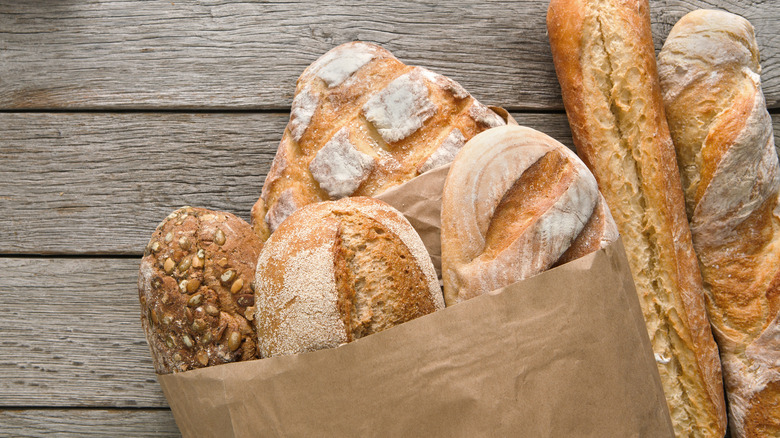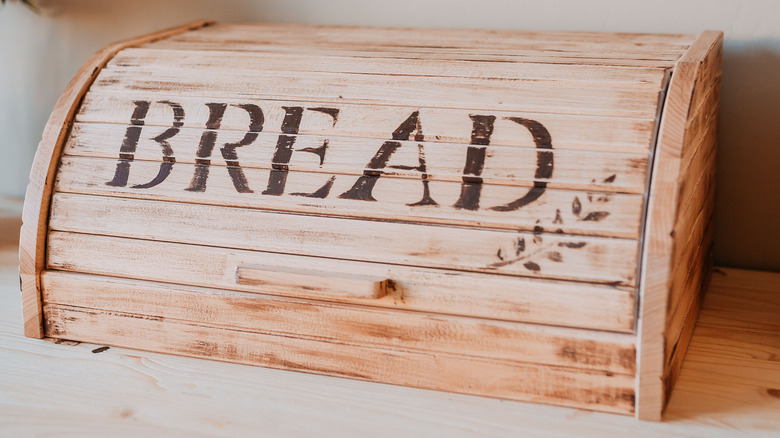The Importance Of Not Storing Fresh Bread In Plastic
There's nothing better than a fresh batch of homemade sourdough. Dip it in some delectable olive oil and pair it with your favorite wine and cheese, and you've got yourself a luxurious snack. However, while making homemade bread is typically healthier and more affordable, you unfortunately run the risk of it going bad more quickly than store-bought bread.
You've probably been told that storing your homemade bread in a plastic bag is the way to go. After all, everything seems to be sealed in plastic for optimal preservation. So why not store homemade bread loaves in plastic, too?
Healthline states that store-bought bread often contains preservatives such as calcium propionate, sodium benzoate, potassium sorbate, and sorbic acid to prevent mold and increase their shelf life, ultimately making it okay to store in plastic. However, homemade bread is prone to spoiling quicker because it lacks these preservatives, meaning your bread will start to harbor bacteria within 3-4 days at room temperature.
Why you should never store your bread in plastic
According to Southern Living, there are better options than storing homemade bread in a plastic bag or container. Why? This is because when bread is stored in plastic, it retains its moisture, becomes soft, and is more likely to grow mold after a couple of days.
If you've ever stored fresh bread in a plastic bag, you'll notice that condensation starts to form, and the bread becomes overly moist. This is because plastic isn't breathable, and the moisture inside the bread works its way outward into the bag's atmosphere. Within a couple of days, your bread will start to harvest bacteria due to the lack of airflow.
So, what type of packaging should you store your bread in to keep it as fresh as possible? Well, there's a reason bread is sold in brown paper bags at your local bakery. Unlike plastic, paper bags allow the bread to stay dry while still remaining firm and crusty. Even though fresh bread is best eaten within two to three days, you can keep it from molding sooner if you store it in a paper bag.
Store homemade bread in paper to keep it fresh
Storing your bread in paper rather than plastic is one of the best ways to keep your loaves fresher for longer. However, there are some other tips you'll want to keep in mind for optimal bread storage. While storing your bread in paper helps prevent the loaf from becoming overly moist, it now runs the risk of becoming too dry. Thankfully, there are plenty of ways to prevent your bread from becoming stale — one of them being repurposing your bread heels.
Bread heels are an important part of a bread loaf, as they hold in the loaf's moisture. Once the heel is removed, the bread runs the risk of becoming prematurely stale. The solution? Save your bread heels and place them on the outside of the loaf. As you continue cutting slices of your bread, place the heel back on the end of the loaf to prevent moisture from escaping. Another tip is to store your bread in a cool, dry, and dark place as opposed to a warm and damp one, which will further accelerate moisture and mold growth. Optimal locations for storing bread are in a cupboard, bread box, or drawer.
Making bread at home can be simple. If you store bread in a paper bag, place it in an optimal environment, and use the heel to keep the interior soft, it's bound to stay fresh, light, and crispy, just like the day it came out of the oven.


